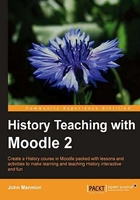
What this book covers
Chapter 1, Course Structure looks at different course formats, effective use of labels, and the creation of a simple forum.
Chapter 2, Create Attractive Courses demonstrates how images and word clouds should be used to enhance course pages.
Chapter 3, Adding Interactive Content focuses on important procedures including uploading of files and creating links for students to submit work. A glossary is also created.
Chapter 4, Quizzes looks at different types of learning objects that can be created and also demonstrates good practice in organizing questions using categories and the question bank.
Chapter 5, The Gradebook looks at ways in which the Gradebook module enables teachers to replicate their markbook electronically and use it for the collation of reports, target setting, and more.
Chapter 6, Student Collaboration examines ways in which students can be encouraged to work and learn together. The chapter looks at wikis, polls, and databases.
Chapter 7, Lessons and Blogs covers modules that reinforce learning. The first module enables teachers to create exciting content that captures their expertise and the second enables students to pursue independent learning.
Chapter 8, Using Xerte and Audacity looks closely at two examples of open source software that enable teachers to add rich content to their Moodle courses.
Chapter 9, Moodle Workshops demonstrates how this important module empowers teachers and students to conduct meaningful and rewarding peer-to-peer assessments of work.